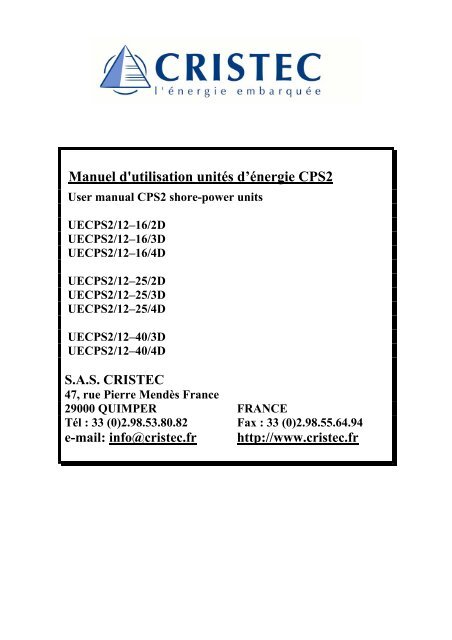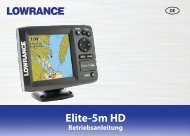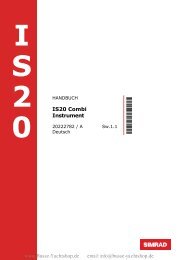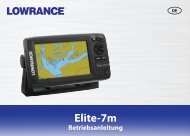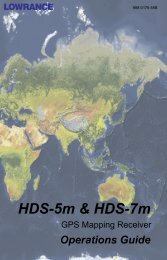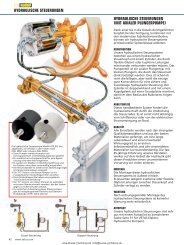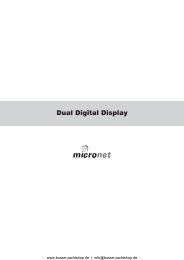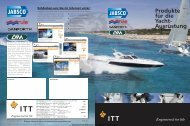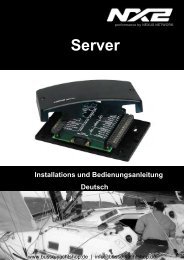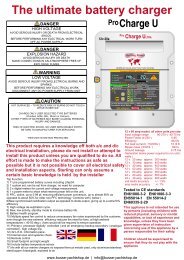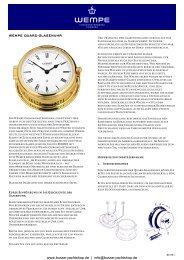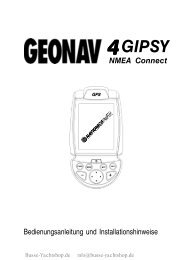Manuel d'utilisation unités d'énergie CPS2 - Kiel Nautik
Manuel d'utilisation unités d'énergie CPS2 - Kiel Nautik
Manuel d'utilisation unités d'énergie CPS2 - Kiel Nautik
Create successful ePaper yourself
Turn your PDF publications into a flip-book with our unique Google optimized e-Paper software.
<strong>Manuel</strong> <strong>d'utilisation</strong> <strong>unités</strong> d’énergie <strong>CPS2</strong><br />
User manual <strong>CPS2</strong> shore-power units<br />
UE<strong>CPS2</strong>/12–16/2D<br />
UE<strong>CPS2</strong>/12–16/3D<br />
UE<strong>CPS2</strong>/12–16/4D<br />
UE<strong>CPS2</strong>/12–25/2D<br />
UE<strong>CPS2</strong>/12–25/3D<br />
UE<strong>CPS2</strong>/12–25/4D<br />
UE<strong>CPS2</strong>/12–40/3D<br />
UE<strong>CPS2</strong>/12–40/4D<br />
S.A.S. CRISTEC<br />
47, rue Pierre Mendès France<br />
29000 QUIMPER FRANCE<br />
Tél : 33 (0)2.98.53.80.82 Fax : 33 (0)2.98.55.64.94<br />
e-mail: info@cristec.fr http://www.cristec.fr
UE<strong>CPS2</strong>-12-16/25/40-DEA.DOC 2
Sommaire Page 4<br />
<strong>Manuel</strong> <strong>d'utilisation</strong> en Français Page 6<br />
Contents Page 5<br />
Operating Manual in English Page 20<br />
Annexe Page 34<br />
UE<strong>CPS2</strong>-12-16/25/40-DEA.DOC 3
SOMMAIRE<br />
1 PRECAUTIONS – GARANTIE .................................................................................................................................................. 6<br />
1.1 PRECAUTIONS.................................................................................................................................................................... 6<br />
1.2 GARANTIE........................................................................................................................................................................... 7<br />
2 SPECIFICATIONS TECHNIQUES............................................................................................................................................ 8<br />
2.1 UE<strong>CPS2</strong> 12V/16A, 12V/25A, 12V/40A ................................................................................................................................ 8<br />
3 FONCTIONNEMENT – CONFIGURATION – REGLAGES - INDICATEURS .................................................................. 9<br />
3.1 PRINCIPE DE FONCTIONNEMENT .................................................................................................................................. 9<br />
3.2 CONFIGURATION DES SWITCHS – REGLAGES - INDICATEURS .............................................................................. 9<br />
3.2.1 Descriptif........................................................................................................................................................................... 9<br />
3.2.2 Disposition des switchs de configuration.......................................................................................................................... 9<br />
3.2.3 Configuration en fonction du type de batteries ............................................................................................................... 10<br />
3.2.3 Réglages.......................................................................................................................................................................... 10<br />
3.2.5 Courbe de charge............................................................................................................................................................ 11<br />
3.2.6 Indicateurs ...................................................................................................................................................................... 12<br />
4 INSTALLATION ........................................................................................................................................................................ 12<br />
4.1 MONTAGE DE L’UNITE D’ENERGIE ........................................................................................................................................ 13<br />
4.2 CABLAGE............................................................................................................................................................................. 13<br />
4.2.1 Arrivée des câbles .............................................................................................................................................................. 13<br />
4.2.2 Câble de liaison réseau alternatif public ou groupe électrogène........................................................................................ 13<br />
4.2.3 Câble de liaison batterie ..................................................................................................................................................... 14<br />
4.2.4 Câble de liaison à la masse de l’installation....................................................................................................................... 14<br />
4.2.5 Dispositions vis à vis des perturbations électromagnétiques générées par l'appareil ........................................................ 14<br />
4.2.6 Options ................................................................................................................................................................................ 15<br />
5 MISE EN SERVICE ................................................................................................................................................................... 16<br />
5.1 RESEAU D’ENTREE................................................................................................................................................................ 16<br />
5.2 COMPATIBILITE ET CONFIGURATION DE L’UNITE D’ENERGIE EN FONCTION DES BATTERIES........................................... 16<br />
5.3 ARRET/MARCHE DE L’UNITE D’ENERGIE............................................................................................................................... 16<br />
6 DISPOSITIONS RELATIVES A LA MAINTENANCE ET A LA REPARATION DE L’EQUIPEMENT...................... 17<br />
6.1 GENERALITES ....................................................................................................................................................................... 17<br />
6.2 MAINTENANCE DES EQUIPEMENTS........................................................................................................................................ 17<br />
6.3 REPARATION DES EQUIPEMENTS .......................................................................................................................................... 17<br />
7 DISPOSITIONS RELATIVES A LA SECURITE................................................................................................................... 17<br />
7.1 REFERENCES NORMATIVES ................................................................................................................................................... 17<br />
7.2 PRECAUTIONS RELATIVES A LA SECURITE DES PERSONNES ................................................................................................... 17<br />
7.3 PRECAUTIONS RELATIVES A LA PROTECTION CONTRE LE FEU ET LES EXPLOSIONS................................................................ 17<br />
8 CERTIFICATION DE CONFORMITE CE............................................................................................................................. 18<br />
UE<strong>CPS2</strong>-12-16/25/40-DEA.DOC 4
CONTENTS<br />
1 PRECAUTIONS – WARRANTY .............................................................................................................................................. 20<br />
1.1 PRECAUTIONS.................................................................................................................................................................. 20<br />
1.2 WARRANTY ...................................................................................................................................................................... 21<br />
2 TECHNICAL SPECIFICATIONS............................................................................................................................................ 22<br />
2.1 UE<strong>CPS2</strong> 12V/16A, 12V/25A, 12V/40A .............................................................................................................................. 22<br />
3 OPERATION – SETTINGS – ADJUSTMENTS - INDICATORS......................................................................................... 23<br />
3.1 OPERATING PRINCIPLE.................................................................................................................................................. 23<br />
3.2 SWITCH SETTINGS – ADJUSTMENTS - INDICATORS................................................................................................ 23<br />
3.2.1 Description...................................................................................................................................................................... 23<br />
3.2.2 Switch settings and positions .......................................................................................................................................... 23<br />
3.2.3 Settings for each type of battery...................................................................................................................................... 24<br />
3.2.4 Settings............................................................................................................................................................................ 24<br />
3.2.5 Load curve ...................................................................................................................................................................... 25<br />
3.2.6 Indicators ........................................................................................................................................................................ 26<br />
4 INSTALLATION ........................................................................................................................................................................ 26<br />
4.1 SITING THE SHORE-POWER UNIT........................................................................................................................................ 27<br />
4.2 WIRING.............................................................................................................................................................................. 27<br />
4.2.1 Cable lead-in ...................................................................................................................................................................... 27<br />
4.2.2 Cable from the public AC power supply network or generator............................................................................................ 27<br />
4.2.3 Battery cable......................................................................................................................................................................... 28<br />
4.2.4 Cable linking the earth to the installation ............................................................................................................................ 28<br />
4.2.5 Precautions regarding electromagnetic disturbance generated by the appliance ............................................................... 28<br />
4.2.6 Options ................................................................................................................................................................................. 29<br />
5 COMMISSIONING .................................................................................................................................................................... 30<br />
5.1 ELECTRICITY NETWORK............................................................................................................................................... 30<br />
5.2 SHORE-POWER UNIT COMPATIBILITY AND SETTINGS ACCORDING TO BATTERY TYPE.............................. 30<br />
5.3 TURNING THE SHORE-POWER UNIT ON AND OFF........................................................................................................... 30<br />
6 EQUIPMENT MAINTENANCE AND REPAIRS................................................................................................................... 31<br />
6.1 OVERVIEW ........................................................................................................................................................................ 31<br />
6.2 EQUIPMENT MAINTENANCE.............................................................................................................................................. 31<br />
6.3 EQUIPMENT REPAIR....................................................................................................................................................... 31<br />
7 SAFETY PRECAUTIONS ......................................................................................................................................................... 31<br />
7.1 REFERENCE STANDARDS.................................................................................................................................................. 31<br />
7.2 PERSONAL SAFETY PRECAUTIONS ................................................................................................................................. 31<br />
7.3 PRECAUTIONS REGARDING THE RISK OF FIRE AND EXPLOSIONS ............................................................................... 31<br />
8 CE CERTIFICATION OF CONFORMITY ............................................................................................................................ 32<br />
UE<strong>CPS2</strong>-12-16/25/40-DEA.DOC 5
1 PRECAUTIONS – GARANTIE<br />
La fourniture CRISTEC comprend les éléments suivants :<br />
1 boîtier métallique contenant la fonction électronique chargeur de batteries et les disjoncteurs de<br />
protection 230V<br />
Le présent manuel <strong>d'utilisation</strong><br />
Le présent document s'applique aux <strong>unités</strong> <strong>d'énergie</strong> de la gamme <strong>CPS2</strong> CRISTEC listées en couverture.<br />
Ce manuel est destiné aux utilisateurs, installateurs et personnels d'entretien de l'équipement. Ceux-ci doivent<br />
impérativement prendre connaissance du présent document avant toute intervention sur l’unité <strong>d'énergie</strong>.<br />
Ce manuel doit être conservé avec soin et consulté avant toute intervention car il contient toutes les<br />
informations relatives à l'utilisation de l'appareil.<br />
Ce document est la propriété de CRISTEC; toutes les informations contenues dans ce document s'appliquent au<br />
produit qui l'accompagne. La société se réserve le droit d'en modifier les spécifications sans préavis.<br />
1.1 PRECAUTIONS<br />
Dispositions vis à vis des échauffements de l'appareil<br />
L'équipement est conçu pour être monté sur une paroi verticale selon les indications fournies dans ce manuel.<br />
Il est impératif de conserver une zone de 150mm autour de l’unité d’énergie. L'installateur prendra les<br />
dispositions nécessaires pour que la température d'air à l'entrée soit inférieure à 40°C dans les conditions<br />
extrêmes de fonctionnement.<br />
Les dispositions nécessaires seront également prises pour permettre un dégagement de l'air chaud de chaque<br />
côté de l’unité d’énergie.<br />
L’unité d’énergie ne doit pas être installée à proximité d'une source de chaleur. Elle doit être installée dans une<br />
zone aérée. Les arrivées et sorties d'air de l’unité d’énergie ne doivent pas être obstruées.<br />
Dispositions vis à vis des poussières, du ruissellement et chutes d'eau<br />
L'emplacement de l’unité d’énergie doit être choisi pour éviter toute pénétration d’humidité, de liquide, de sel<br />
ou de poussières dans l’unité d’énergie.<br />
Ces incidents peuvent générer une dégradation irréversible du matériel et un danger potentiel pour l'utilisateur.<br />
L'appareil doit être positionné dans un endroit sec et bien ventilé.<br />
Dispositions vis à vis des matériels inflammables<br />
L’unité d’énergie ne doit pas être utilisée à proximité de matériels, liquides ou gaz inflammables.<br />
Les batteries sont susceptibles d'émettre des gaz explosifs : pour l'installation des batteries, prendre en compte<br />
les prescriptions de leur constructeur.<br />
Dispositions vis à vis des courants de fuite accidentels à la terre<br />
La barre de terre PE de l’unité d’énergie doit être impérativement raccordée à la terre de l'installation. Elle doit<br />
être raccordée avant toutes les autres bornes (voir plan correspondant en annexe).<br />
L’unité d’énergie doit être fermée avant toute mise sous tension : le capot doit être relié au châssis de l’unité<br />
d’énergie par les vis prévues à cet effet.<br />
UE<strong>CPS2</strong>-12-16/25/40-DEA.DOC 6
Courant de fuite accidentel entre phase et terre : se conformer à la norme NFC15-100 pour les précautions<br />
d'installation.<br />
Faire réaliser les travaux de raccordement par un électricien ou un installateur professionnel.<br />
Courant de fuite accidentel entre circuit de charge et masse : la détection des courants de fuite accidentels à<br />
la masse doit être assurée par un dispositif de protection extérieur à l’unité d’énergie (dispositif à courant<br />
différentiel résiduel ou contrôleur d'isolement).<br />
Le calibre et la nature de la protection seront adaptés par l'installateur en fonction des risques. Des précautions<br />
particulières sont recommandées sur toute installation susceptible de craindre des phénomènes électrolytiques.<br />
La réglementation impose la présence de coupe-batteries en sortie sur le pôle + et le pôle -.<br />
Dispositions vis à vis des chocs de foudre<br />
Dans les zones géographiques fortement exposées, il peut être utile de placer un parafoudre en amont de l’unité<br />
d’énergie afin d'éviter toute dégradation irréversible de ce dernier.<br />
Autres dispositions<br />
Ne pas percer ou usiner le coffret de l’unité d’énergie : risque de casse de composants ou de projection de<br />
copeaux ou limailles sur la carte chargeur.<br />
Tout ce qui n'est pas stipulé dans ce manuel est rigoureusement interdit.<br />
1.2 GARANTIE<br />
Le non respect des règles d'installation et <strong>d'utilisation</strong> annule la garantie constructeur et dégage la société<br />
CRISTEC de toute responsabilité.<br />
La durée de garantie est de 36 mois. Elle s'applique aux pièces ainsi qu'à la main d'œuvre pour un matériel<br />
rendu usine de Quimper. Seuls les éléments reconnus défectueux d'origine seront remplacés dans le cadre de la<br />
garantie.<br />
Notre garantie est exclue pour :<br />
1 - Non respect du présent manuel<br />
2 - Toute modification et intervention mécanique, électrique ou électronique sur l'appareil<br />
3 - Toute mauvaise utilisation<br />
4 - Toute trace d'humidité<br />
5 - Non respect des tolérances d'alimentation<br />
6 - Toute erreur dans les connexions<br />
7 - Toute chute ou choc lors du transport, de l'installation ou de l'utilisation<br />
8 - Toute intervention de personnes non autorisées par CRISTEC<br />
9 - Toute connexion d'interfaces non fournies par CRISTEC<br />
10 - Les frais d'emballage et de port<br />
11 - Les dommages apparents ou cachés occasionnés par les transports et /ou manutentions (tout recours doit<br />
être adressé au transporteur)<br />
Notre garantie ne peut en aucun cas donner lieu à une indemnité. CRISTEC ne peut être tenu pour responsable<br />
des dommages dus à une mauvaise utilisation de l’unité d’énergie.<br />
UE<strong>CPS2</strong>-12-16/25/40-DEA.DOC 7
2 SPECIFICATIONS TECHNIQUES<br />
2.1 UE<strong>CPS2</strong> 12V/16A, 12V/25A, 12V/40A<br />
Modèle UE<strong>CPS2</strong>/12-16 UE<strong>CPS2</strong>/12-25 UE<strong>CPS2</strong>/12-40<br />
Entrée<br />
Tension 230VCA monophasé +/-15%<br />
Fréquence De 47 à 63Hz<br />
Intensité de consommation 230VCA 1,4A 2A 3,2A<br />
Facteur de puissance 0,9 aux conditions nominales<br />
Rendement > 80% aux conditions nominales<br />
Fusibles d’entrée F1/F2 2 x 6,3A/250V – Réf.DEL MICRO<br />
FUSE 00346623MST<br />
2 x 10A/250V –<br />
6,3x 32<br />
Sortie<br />
Nombre de sorties 3 sorties séparées BAT D, BAT 1 et BAT 2 (répartiteur intégré). Chaque<br />
sortie peut être utilisée seule et débiter le courant total<br />
Courant nominal total (+/-7%) /<br />
Puissance nominale<br />
16A/228W 25A/356W 40A/570W<br />
Courbe de charge Choix du type de charge par commutateur interne IU ou IUoU (Boost,<br />
Absorption, Floating – configuration usine).<br />
Type de batteries Voir tableau de configuration des switchs<br />
Tension de sortie régulée et filtrée Voir tableau de configuration des switchs. Les chargeurs peuvent fonctionner<br />
en alimentation à courant continu.<br />
Tolérance de régulation avant répartiteur<br />
et fusibles<br />
< 2%<br />
Ondulation et bruit crête à crête < 250mV < 250mV < 250mV<br />
Fusibles automotive de sortie montés en<br />
parallèle dans le pôle BAT -<br />
Environnement<br />
1 x 20A/32V (F3) 1 x 25A/32V (F3)<br />
2 x 20A/32V<br />
(F3/F4)<br />
Température de fonctionnement -10°C à +45°C ; +45°C à +50°C avec dérating de 10% de Pnom/°C<br />
Refroidissement Dissipation Ventilateur souffleur piloté par sonde thermique interne<br />
naturelle<br />
60°C +/-5°C<br />
Humidité relative Jusqu’à 70% (95% sans condensation)<br />
Température de stockage<br />
Coffret<br />
-20°C à +70°C<br />
Matériau Coffret composé de 2 pièces : châssis en aluminium et capot en acier.<br />
Peinture Revêtement époxy noir mat et gris<br />
Dimensions hors presse-étoupe (longueur, 375 x 242 x 375 x 242 x 395 x 262 x<br />
hauteur, profondeur) / Poids<br />
106mm / 3,6Kg 106mm / 3,7Kg 116mm / 5,6Kg<br />
Entraxes de fixation 357x 190mm 357x 190mm 377 x 190mm<br />
Vis de fixation (murale) 4 vis M5 tête ronde<br />
Indice de protection IP21<br />
Protection carte<br />
Normes<br />
Tropicalisation par vernis hydrofuge (ambiance marine)<br />
Marquage CE/CEM NF EN6100-6-1, NF EN6100-6-2, NF EN6100-6-3, NF 6100-6-4<br />
Marquage CE/sécurité NF EN60950, NF EN603635-2-29<br />
Protections électriques - Contre les surtensions d’entrée fugitives par casse varistance<br />
- Contre les inversions de polarité en sortie par casse du fusible<br />
- Contre les courts-circuits et les surcharges en sortie<br />
- Contre les échauffements anormaux par coupure chargeur (sonde thermique<br />
interne 90°C)<br />
- Contre les surtensions de sortie<br />
UE<strong>CPS2</strong>-12-16/25/40-DEA.DOC 8
3 FONCTIONNEMENT – CONFIGURATION – REGLAGES - INDICATEURS<br />
3.1 PRINCIPE DE FONCTIONNEMENT<br />
Les <strong>unités</strong> d’énergie CRISTEC permettent de disposer dans un même coffret de la protection 230V du bord et<br />
d’un chargeur de batteries.<br />
L’ensemble répond aux normes européennes en vigueur et permet, grâce à son coffret compact, d’optimiser<br />
l’encombrement et le temps de montage.<br />
La protection utilisateur se compose d’un disjoncteur 16A-230V bipolaire différentiel 30 mA. Les départs du<br />
bord sont eux protégés par 2, 3 ou 4 disjoncteurs magnéto - thermiques DPN 10A.<br />
La fonction chargeur est assurée par une carte électronique à découpage H.F directement issue de notre gamme<br />
de chargeurs <strong>CPS2</strong>.<br />
Ils sont conçus sur la base d’un convertisseur à découpage haute fréquence qui transforme le signal alternatif en<br />
une tension continue, régulée et filtrée. Ils peuvent fonctionner en chargeur de batteries et en alimentation à<br />
courant continu.<br />
Le fonctionnement de l’unité d’énergie est entièrement automatique, après sélection préalable du type de<br />
batterie et du type de charge. Elle peut rester raccordée de façon permanente aux batteries et ne nécessite pas<br />
d'être déconnectée lors du démarrage moteur (application marine) car équipée de diodes anti-retour.<br />
L'appareil délivre une tension adaptée à la recharge de 1, 2 ou 3 batteries séparées (répartiteurs de charge<br />
intégrés, séparation des batteries). Tous les modèles sont dotés d'une sortie adaptée à la recharge de la batterie<br />
moteur (sortie BAT D, application marine). Le chargeur peut débiter au maximum le courant nominal réparti<br />
sur chaque sortie en fonction du besoin utilisation batterie.<br />
Chaque sortie peut débiter le courant nominal.<br />
Toutes les sorties ne sont pas obligatoirement à connecter. Cependant, si une seule sortie est utilisée, il est<br />
recommandé de relier les sorties BAT1, BAT2 et BAT D entre elles (facultatif).<br />
3.2 CONFIGURATION DES SWITCHS – REGLAGES - INDICATEURS<br />
3.2.1 Descriptif<br />
Les <strong>unités</strong> d’énergies <strong>CPS2</strong> sont équipées de switchs permettant de configurer le chargeur en fonction du type<br />
de batteries et d'application. Les chargeurs <strong>CPS2</strong> sont dotés de la fonction Boost qui permet une recharge plus<br />
rapide des batteries. Cette fonction est temporisée dans le temps (4 heures +/- 10 minutes) et est inhibée<br />
automatiquement si la batterie est chargée : arrêt du Boost pour I batteries < 15% de I chargeur nominal.<br />
La fonction Boost peut également être inhibée par un switch.<br />
3.2.2 Disposition des switchs de configuration<br />
SW1 : Sélection de la fonction BOOST<br />
SW2 à SW5 : Sélection du type de batteries<br />
UE<strong>CPS2</strong>-12-16/25/40-DEA.DOC 9
3.2.3 Configuration en fonction du type de batteries<br />
Type de Batterie Disposition des Switchs<br />
BAT.TYPE 1<br />
Plomb Calcium Etain (ex :<br />
Delphi / Delco Freedom)<br />
BAT.TYPE 2<br />
Plomb Etanche<br />
BAT.TYPE 3<br />
Plomb Gélifié ou Plomb<br />
Calcium<br />
BAT.TYPE 4<br />
Plomb Ouvert avec entretien<br />
(électrolyte libre)<br />
HIVERNAGE<br />
pour BAT.TYPE 1<br />
BAT.TYPE 2<br />
BAT.TYPE 3<br />
HIVERNAGE<br />
pour BAT.TYPE 4<br />
SW5 SW4 SW3 SW2 SW1<br />
Boost<br />
Tension<br />
Phase<br />
Boost*<br />
<strong>CPS2</strong> 12V<br />
Tension<br />
Phase<br />
Floating*<br />
OFF OFF OFF ON ON 15,1V 14,4V<br />
OFF OFF ON OFF ON 14,3V 13,6V<br />
OFF ON OFF OFF ON 14,1V 13,4V<br />
ON OFF OFF OFF ON 13,7V 13V<br />
OFF ON OFF OFF ON 14,1V 13,4V<br />
ON OFF OFF OFF ON 13,7V 13V<br />
(*) Tension sur BAT 1 / BAT 2 avec 10% du courant nominal avec une tolérance de +/- 1%<br />
Tension sur BAT D = BAT 1 ou BAT 2 – 0,4V environ<br />
3.2.3 Réglages<br />
L’unité d’énergie est configurée en sortie d'usine :<br />
BAT.TYPE 2 Plomb étanche (voir tableau précédent)<br />
BOOST en position ON<br />
L'installateur doit configurer (hors tension entrée et sortie/à vide) les switchs et éventuellement ajuster la<br />
tension de sortie via le potentiomètre RV1 (utiliser l'outil adéquat pour tourner la vis du potentiomètre) en<br />
fonction :<br />
- du type de batterie (contacter le constructeur de batteries si nécessaire)<br />
- du type <strong>d'utilisation</strong><br />
- de la section et longueur des câbles de sortie<br />
- de la nécessité ou non de la fonction boost<br />
En cas de batteries spéciales, se référer à un installateur professionnel qui effectuera les réglages particuliers en<br />
accord avec les spécifications du constructeur d'accumulateurs et en tenant compte des particularités de<br />
l'installation.<br />
CRISTEC décline toute responsabilité en cas de détérioration des batteries ou de mauvaise recharge.<br />
UE<strong>CPS2</strong>-12-16/25/40-DEA.DOC 10
3.2.5 Courbe de charge<br />
Boost en position ON<br />
Dans cette configuration l’unité d’énergie <strong>CPS2</strong> délivre une courbe de charge 3 états IUoU : Boost, Absorption,<br />
Floating.<br />
Batterie déchargée Batterie faiblement déchargée<br />
U out<br />
charger<br />
I out<br />
charger<br />
0<br />
I nom<br />
0<br />
Boost Absorption Floating<br />
U boost<br />
4 Hrs<br />
4 Hrs<br />
U floating<br />
Boost Absorption Floating<br />
t<br />
U out<br />
charger<br />
I out<br />
charger<br />
Boost Absorption Floating<br />
< 4 Hrs<br />
U floating<br />
UE<strong>CPS2</strong>-12-16/25/40-DEA.DOC 11<br />
0<br />
I nom<br />
15% I nom<br />
t 0<br />
U boost<br />
Boost Absorption Floating<br />
15% I nom<br />
< 4 Hrs<br />
Phase Boost : démarre automatiquement à la mise sous tension de l’unité d’énergie si la batterie est déchargée.<br />
Le courant est alors maximum.<br />
Phase Absorption : commence dès que la tension a atteint la valeur maximale du Boost. Le courant commence à<br />
décroître.<br />
Ces deux phases cumulées durent au maximum 4 heures. Si le courant atteint une valeur inférieure à 15% du<br />
courant nominal, la phase floating s’enclenche automatiquement. La durée et le courant dépendent de l'état de<br />
charge de la batterie.<br />
Phase Floating : débute au bout de 4 heures ou si le courant délivré a atteint 15% du courant nominal de l’unité<br />
d’énergie. La tension bascule à la valeur Floating et le courant continu à décroître.<br />
t<br />
t
Boost en position OFF<br />
Dans cette configuration, l’unité d’énergie <strong>CPS2</strong> délivre une courbe de charge de type mono-palier IU. Elle<br />
génère une tension constante et fournit le courant nécessaire à la ou les batteries. Le temps de recharge dépend<br />
de l'état de la batterie et est plus long que dans la configuration boost en position ON.<br />
3.2.6 Indicateurs<br />
U out<br />
charger<br />
I out<br />
charger<br />
0<br />
I nom<br />
U floating<br />
t<br />
INDICATEUR ETAT SIGNIFICATION<br />
Vert "ON" Allumé - Chargeur sous tension<br />
Eteint<br />
- Absence ou dégradation du réseau alternatif<br />
ou - Rupture fusible entrée<br />
ou - Dysfonctionnement interne de l’unité d’énergie<br />
ou - Retombée du disjoncteur différentiel d’entrée<br />
Jaune "Boost / Allumé - Switch SW1 : Boost en position OFF<br />
Absorption"<br />
ou - Swich SW1 : Boost en position ON et phase de Boost/Absorption achevée<br />
Clignotant - Switch SW1 : Boost en position ON et chargeur en cours de phase de<br />
Boost/Absorption<br />
Eteint<br />
-Dysfonctionnement interne de l’unité d’énergie<br />
ou - Rupture du fusible de sortie<br />
Jaune "Floating" Allumé Courant chargeur < 15% du courant nominal (phase de Floating)<br />
Eteint Courant chargeur > 15% du courant nominal<br />
Ces indicateurs sont visibles en façade de l'appareil au travers de guides de lumière et permettent une<br />
visualisation du mode de fonctionnement de l'appareil.<br />
4 INSTALLATION<br />
Ce paragraphe traite des dispositions relatives à l'installation de l'équipement.<br />
L'installation et la première mise en fonctionnement doivent être assurées par un électricien ou un<br />
installateur professionnel selon les normes en vigueur (dans le cas des navires de plaisance, se<br />
conformer à la norme internationale ISO13297).<br />
L'installateur devra prendre connaissance de ce manuel <strong>d'utilisation</strong> et devra informer les utilisateurs<br />
des dispositions relatives à l'utilisation et à la sécurité contenues au paragraphe 7.<br />
UE<strong>CPS2</strong>-12-16/25/40-DEA.DOC 12
4.1 MONTAGE DE L’UNITE D’ENERGIE<br />
L’unité d’énergie <strong>CPS2</strong> devra être installée au plus prêt des batteries dans un local sec, ventilé, à l’abri<br />
de toute pénétration d’humidité et de toute poussière. Sa circulation d’air doit être libre.<br />
Les recommandations citées dans le paragraphe 1 doivent être respectées. Il est impératif de positionner<br />
l’unité d’énergie en position verticale (arrivée des câbles par le bas).<br />
La fixation de l’unité d’énergie se fait par 4 vis M5 tête ronde (diamètre de la tête de vis inférieur < à<br />
10mm afin d’assurer l’ouverture du capot).<br />
Entraxe de fixation : voir plan correspondant en annexe.<br />
4.2 CABLAGE<br />
4.2.1 Arrivée des câbles<br />
L’arrivée du câble secteur se fait au travers d’un presse-étoupe.<br />
L’arrivée des câbles batteries et/ou utilisation se fait au travers de passe-câbles.<br />
L’arrivée des câbles « options » (voir paragraphe 4.2.6 options) se fait au travers de deux encoches<br />
situées au-dessus des passe-câbles.<br />
Pour connecter et déconnecter un câble, l’alimentation de l’unité d’énergie doit impérativement être<br />
coupée et les batteries isolées électriquement de l’unité d’énergie.<br />
Les références des fournitures complémentaires nécessaires au bon fonctionnement de l'appareil sont<br />
définies dans les paragraphes ci-dessous : tout non-respect de ces dispositions entraîne une annulation<br />
systématique de la garantie.<br />
4.2.2 Câble de liaison réseau alternatif public ou groupe électrogène<br />
Le câble d’alimentation doit se connecter sur le bornier à vis K1 (bornes PE, ACN et ACL) :<br />
PE : Terre<br />
ACN : Neutre<br />
ACL : Phase<br />
Selon les longueurs de ligne, les câbles de liaison réseau alternatif devront être obligatoirement de section<br />
supérieure ou égale aux valeurs indiquées dans le tableau ci-dessous * :<br />
Modèle<br />
<strong>CPS2</strong>/12-16<br />
<strong>CPS2</strong>/12-25<br />
Section minimale et types de<br />
câble en 230VCA<br />
3 x 1,5 mm² HO7-VK<br />
<strong>CPS2</strong>/12-40 3 x 1,5 mm² HO7-VK<br />
Utiliser impérativement des embouts à collerette isolante en corrélation avec les normes de l’installation<br />
pour le raccordement de l'entrée alternative réseau.<br />
Le conducteur PE (communément appelé "terre", fil vert/jaune) de la source alternative doit<br />
impérativement être raccordé à l’unité d’énergie sur la borne prévue à cet effet et avant toute autre<br />
borne.<br />
Se reporter au plan correspondant en annexe.<br />
UE<strong>CPS2</strong>-12-16/25/40-DEA.DOC 13
4.2.3 Câble de liaison batterie<br />
Le chargeur de l’unité d’énergie <strong>CPS2</strong> est équipé de 4 bornes de sortie :<br />
K4 : - BAT (moins parc batteries)<br />
K5 : +BAT D (plus batterie de démarrage pour application de type marine)<br />
K6 : +BAT 1 (plus batterie parc 1)<br />
K7 : +BAT 2 (plus batterie parc 2)<br />
Jusqu’à 3 mètres, les câbles de liaison batteries doivent être obligatoirement de section supérieure ou égale aux<br />
valeurs indiquées dans le tableau ci-dessous :<br />
Modèle<br />
Section des câbles de<br />
liaison batteries<br />
Diamètre du trou<br />
de la cosse<br />
<strong>CPS2</strong>/12-16 6mm² 5mm<br />
<strong>CPS2</strong>/12-25 10mm² 5mm<br />
<strong>CPS2</strong>/12-40 16mm² 5mm<br />
Le type de câble (H07-VK, MX…) devra être défini par l’installateur en fonction du type d’application<br />
et des normes applicables.<br />
Conserver impérativement les passe-câbles ou les presse-étoupe sur la face inférieure du coffret pour<br />
éviter toute dégradation des câbles de liaison sur les parois métalliques du coffret et garantir une<br />
isolation entre les conducteurs actifs et la masse électrique.<br />
Voir plan correspondant en annexe.<br />
4.2.4 Câble de liaison à la masse de l’installation<br />
En fonction des normes en vigueur de l’application concernée, le coffret de l’unité d’énergie devra être<br />
relié au plan de masse de l’installation.<br />
Pour cela, connecter le câble de liaison à la masse de l’installation à la vis de masse située à l’intérieur<br />
de l’unité d’énergie (voir plan en annexe).<br />
Le câble utilisé doit avoir une section minimale de 2,5mm² et être de type HO7-VK et être muni d’une<br />
cosse appropriée.<br />
4.2.5 Dispositions vis à vis des perturbations électromagnétiques générées par l'appareil<br />
Utiliser du câble blindé pour toutes les connexions (*). Le blindage doit être raccordé côté émetteur et<br />
côté récepteur à la masse.<br />
Réduire au maximum la longueur des câbles et les connexions des blindages.<br />
Faire passer les câbles au plus près des masses (les câbles "volants" ou les boucles sont à éviter -<br />
plaquer les câbles contre les masses).<br />
Séparer les câbles d'alimentation et <strong>d'utilisation</strong>.<br />
Séparer les câbles de puissance et les câbles de contrôle (minimum 200mm).<br />
Les câbles doivent assurer uniquement l'alimentation de l'appareil. Une dérivation ou un pontage afin<br />
d'alimenter un autre appareil sont à prohiber.<br />
(*) Ceci est un conseil d'installation et non une obligation. L'électricien installateur décide, compte<br />
tenu de l'environnement CEM, de l'emploi de câble blindé ou non.<br />
UE<strong>CPS2</strong>-12-16/25/40-DEA.DOC 14
4.2.6 Options<br />
Les options ne font pas partie de la fourniture de base des <strong>unités</strong> d’énergies <strong>CPS2</strong>; elles sont<br />
disponibles auprès de votre revendeur. Seules les options commercialisées par CRISTEC peuvent être<br />
montées avec les chargeurs.<br />
Les options disponibles pour la gamme <strong>CPS2</strong> sont :<br />
Commande Arrêt/Marche du chargeur à distance : référence A/M-<strong>CPS2</strong><br />
Câble de 5 mètres + commutateur Arrêt/Marche; à connecter sur connecteur K8 (voir plan en annexe)<br />
Commande Boost à distance : référence BAD-<strong>CPS2</strong><br />
Câble de 5 mètres + commutateur Boost ON/Boost OFF, à connecter sur K11 (voir plan en annexe)<br />
Sonde de température : référence STP-<strong>CPS2</strong><br />
Permet la compensation de la tension de charge en fonction de la température<br />
Chargeur 12V : -18mV/°C<br />
Câble de 5 mètres + sonde, à connecter sur K2 (voir plan annexe)<br />
Afficheur numérique : référence SEEL009104<br />
Permet d’afficher l’état du chargeur (ON/OFF), le courant chargeur, la tension de chacune des 3 sorties<br />
et le pourcentage de charge des batteries<br />
Câble de 10 mètres + afficheur, à connecter sur K3<br />
Câbles pour afficheurs analogiques : référence DEP-V-A_<strong>CPS2</strong><br />
Permet de connecter les options analogiques voltmètre (de 1 à 4 en fonction du nombre de sorties à<br />
contrôler : Bat D, Bat 1, Bat 2 ou tension avant répartiteur) et ampèremètre<br />
Câble de 5 mètres, à connecter sur K10 (voir plan en annexe)<br />
Voltmètre analogique 48x48mm pour visualiser la tension d’une sortie ou la tension du chargeur<br />
avant répartiteur<br />
Référence : VLT0012-<strong>CPS2</strong> pour les chargeurs 12Vcc<br />
A connecter sur K10 avec l’option DEP-V-A-<strong>CPS2</strong><br />
Ampèremètre analogique 48x48mm pour visualiser le courant total du chargeur, à connecter sur<br />
K10 avec l’option DEP-V-A-<strong>CPS2</strong><br />
Modèle Référence<br />
<strong>CPS2</strong>/12-16 AMP 12V/16A <strong>CPS2</strong><br />
<strong>CPS2</strong>/12-25 AMP 12V/25A <strong>CPS2</strong><br />
<strong>CPS2</strong>/12-40 AMP 12V/40A <strong>CPS2</strong><br />
Option LEDs déportées : référence LED-DEP-<strong>CPS2</strong><br />
Câble de 5 mètres, à connecter sur KLD1/KLD2/KLD3<br />
UE<strong>CPS2</strong>-12-16/25/40-DEA.DOC 15
5 MISE EN SERVICE<br />
Ce paragraphe énumère les opérations à effectuer pour la mise en service de l’équipement.<br />
Il convient de respecter strictement ces instructions avant la première mise sous tension.<br />
5.1 RESEAU D’ENTREE<br />
Toutes les <strong>unités</strong> d’énergies <strong>CPS2</strong> peuvent fonctionner automatiquement et indiféremment à partir du réseau<br />
monophasé 230VCA +/-15% et de 47 à 63Hz.<br />
Caractéristiques distribution CA :<br />
• Protection générale, à l'entrée, par : disjoncteur 16A bipolaire différentiel 30 mA,<br />
• Départs alternatifs : Protection par 2, 3 ou 4 (selon modèle) disjoncteurs magnéto - thermiques DPN 10A.<br />
Groupes électrogènes<br />
L’unité d’énergie CRISTEC est conçue pour fonctionner sur groupe électrogène. Dans certains cas, les groupes<br />
électrogènes peuvent générer des surtensions importantes. Avant raccordement de l’unité d’énergie, vérifier la<br />
compatibilité des caractéristiques du groupe et celles de l’unité d’énergie : puissance, tension, surtension,<br />
fréquence, courant…<br />
5.2 COMPATIBILITE ET CONFIGURATION DE L’UNITE D’ENERGIE EN FONCTION DES<br />
BATTERIES<br />
Vérifier impérativement la compatibilité de tension, de courant et la configuration en fonction du type de<br />
batteries raccordé avant toute mise sous tension.<br />
Vérification de la tension de charge<br />
Avant raccordement des batteries à l’unité d’énergie, il est impératif de vérifier la polarité des accumulateurs.<br />
Vérifier également la tension des batteries à l’aide d’un voltmètre étalonné. Une valeur trop basse de tension<br />
sur certains types d’accumulateurs peut indiquer une dégradation irréversible de ceux-ci et donc une<br />
impossibilité de recharge.<br />
5.3 ARRET/MARCHE DE L’UNITE D’ENERGIE<br />
L’unité d’énergie <strong>CPS2</strong> est en fonctionnement dès lors qu’elle est sous tension (câble de réseau d’entrée<br />
connecté et alimenté).<br />
L’unité d’énergie <strong>CPS2</strong> est à l’arrêt dès qu’elle n’est plus sous tension (câble de réseau d’entrée déconnecté ou<br />
disjoncteur de l’installation sur la position OFF).<br />
ATTENTION : si l’option Arrêt/Marche du chargeur est utilisée, le chargeur peut être à l’arrêt mais l’unité<br />
d’énergie néanmoins sous tension (tension dangereuse).<br />
UE<strong>CPS2</strong>-12-16/25/40-DEA.DOC 16
6 DISPOSITIONS RELATIVES A LA MAINTENANCE ET A LA REPARATION DE<br />
L’EQUIPEMENT<br />
6.1 GENERALITES<br />
Ce paragraphe traite des dispositions relatives à la maintenance et aux réparations de l’équipement. Le bon<br />
fonctionnement et la durée de vie du produit sont conditionnés par le strict respect des recommandations<br />
contenues ci-après.<br />
6.2 MAINTENANCE DES EQUIPEMENTS<br />
Déconnecter l’unité d’énergie du réseau alternatif pour toutes les opérations de maintenance.<br />
Si les appareils sont placés dans une ambiance poussiéreuse, les nettoyer périodiquement par aspiration, les<br />
dépôts de poussière pouvant altérer l’évacuation de la chaleur.<br />
Vérifier l’état de charge des batteries tous les 3 mois.<br />
Une vérification annuelle du serrage des écrous et vis est nécessaire pour garantir le bon fonctionnement de<br />
l’appareil (particulièrement en milieu perturbé : vibrations, chocs, écarts de température importants, etc.).<br />
Une visite technique complète par un intervenant recommandé CRISTEC est conseillé tous les 5 ans. Ce<br />
contrôle technique général peut également être réalisé en nos usines.<br />
6.3 REPARATION DES EQUIPEMENTS<br />
Déconnecter l’unité d’énergie du réseau alternatif et des batteries pour toute opération de réparation.<br />
En cas de rupture des fusibles, respecter le calibre et le type de fusible préconisé dans la présente notice.<br />
Pour toute autre intervention de réparation, contacter un revendeur ou la société CRISTEC.<br />
7 DISPOSITIONS RELATIVES A LA SECURITE<br />
7.1 REFERENCES NORMATIVES<br />
Matériel de classe I selon la norme NF EN 60950<br />
Les prescriptions d’installation sont contenues dans la norme NFC 15-100 et la norme spécifique « aux navires<br />
de plaisance – systèmes électriques- Installation de distribution de courant alternatif » de référence ISO13297.<br />
7.2 PRECAUTIONS RELATIVES A LA SECURITE DES PERSONNES<br />
L'installation doit être réalisée par un électricien ou un installateur professionnel.<br />
Le réseau d'entrée alternatif doit être coupé avant toute intervention sur l'équipement.<br />
7.3 PRECAUTIONS RELATIVES A LA PROTECTION CONTRE LE FEU ET LES EXPLOSIONS<br />
Utiliser les fusibles définis dans la présente notice.<br />
A proximité des batteries : ventiler le local, ne pas fumer, ne pas utiliser de flamme vive.<br />
UE<strong>CPS2</strong>-12-16/25/40-DEA.DOC 17
8 CERTIFICATION DE CONFORMITE CE<br />
Constructeur : CRISTEC<br />
DECLARATION DE CONFORMITE<br />
aux dispositions de la directive 89/336/CEE<br />
"Compatibilité Électromagnétique"<br />
et aux dispositions de la directive 73/23/CEE<br />
"Basse Tension"<br />
Adresse : 47 Avenue Pierre Mendès France – 29000 Quimper/FRANCE<br />
Déclare que les <strong>unités</strong> d’énergies <strong>CPS2</strong> : 12V/16A, 12V/25A, 12V/40A.<br />
Sont conformes aux dispositions de la directive 89/336/CEE et aux dispositions de la<br />
directive73/23/CEE.<br />
Les normes harmonisées appliquées sont les suivantes :<br />
NF EN61000-6-1: Compatibilité électromagnétique (CEM) - Partie 6-1 : normes génériques - Immunité pour<br />
les environnements résidentiels, commerciaux et de l'industrie légère.<br />
NF EN61000-6-2: Compatibilité électromagnétique (CEM) - Partie 6-2 : normes génériques - Immunité pour<br />
les environnements industriels.<br />
NF EN61000-6-3: Compatibilité électromagnétique (CEM) - Partie 6-3 : normes génériques - Norme sur<br />
l'émission pour les environnements résidentiels, commerciaux et de l'industrie légère.<br />
NF EN61000-6-4: Compatibilité électromagnétique (CEM) - Partie 6-4 : normes génériques - Norme sur<br />
l'émission pour les environnements industriels.<br />
NF EN 60950-1: Matériels de traitement de l'information - Sécurité - Partie 1 : prescriptions générales.<br />
Lieu, date et signatures : Quimper, 08/06/2007<br />
Nom et titre des signataires :<br />
Moulay TAOUFIK, Chef Produits Didier MARGERAND, Président<br />
Année d'approbation du marquage CE : 2007<br />
UE<strong>CPS2</strong>-12-16/25/40-DEA.DOC 18
UE<strong>CPS2</strong>-12-16/25/40-DEA.DOC 19
1 PRECAUTIONS – WARRANTY<br />
The Cristec includes the following :<br />
1 metal box containing the battery charger's electronic functions and the 230VAC protection circuit<br />
breakers<br />
This operating manual<br />
This document applies to shore-power units in the <strong>CPS2</strong> CRISTEC range as listed on the cover.<br />
The manual is intended for users, installers and equipment maintenance staff. Please read this manual carefully<br />
before working on the shore-power unit.<br />
This manual should be kept safely and consulted before attempting any repairs, because it contains all the<br />
information required to use the appliance.<br />
This document is the property of CRISTEC; all the information it contains applies to the accompanying<br />
product. CRISTEC reserves the right to modify the specifications without notice.<br />
1.1 PRECAUTIONS<br />
Precautions regarding overheating of the appliance<br />
This appliance is designed to be mounted on a vertical wall or partition as indicated herein.<br />
It is imperative that there be a gap of 150mm around the shore-power unit. The installer must see to it that the<br />
temperature of the air at the input is lower than 40°C in extreme operating conditions.<br />
Measures should also be taken to allow for the discharge of hot air on either side of the shore-power unit.<br />
The shore-power unit must not be installed near a source of heat; it should be installed in a well-ventilated area.<br />
The shore-power unit's air inlets and outlets must not be obstructed.<br />
Precautions regarding dust, seepage and falling water<br />
The shore-power unit should be located so as to prevent penetration of damp, liquids, salt and dust, any of<br />
which could cause irreparable damage to the equipment and be potentially hazardous for the user.<br />
The appliance should be installed in a dry and well-ventilated place.<br />
Precautions regarding inflammable materials<br />
The shore-power unit should not be used near inflammable materials, liquids or gases.<br />
The batteries can emit explosive gases: please follow the manufacturer's instructions carefully when installing<br />
them.<br />
Precautions regarding accidental earthing leaks<br />
The PE terminal must be earthed and connected before any of the other terminals (see relevant diagram in the<br />
appendix).<br />
The shore-power unit must be closed before it is turned on: the cover must be fixed to the shore-power unit's<br />
body with the screw provided for the purpose.<br />
UE<strong>CPS2</strong>-12-16/25/40-DEA.DOC 20
Accidental leakage current between phase and earth: standard NFC15-100 should be followed when<br />
installing.<br />
Use the services of an electrician or professional installer to make the necessary connections.<br />
Accidental leakage current between the charge circuit and the earth: accidental current leakage at the earth<br />
must be detected by means of an independent protective device outside the shore-power unit (a residual current<br />
device or an insulation detector).<br />
The installer should decide on the rating and nature of the protection according to the risks. Special precautions<br />
should be taken on any installation prone to electrolytic phenomena. Regulations require the presence of a<br />
battery cut-off at the outputs on the + and - poles.<br />
Precautions regarding lightning<br />
In areas highly exposed to lightning, it may be advisable to install a lightning arrestor upstream of the shorepower<br />
unit to safeguard it against irreversible damage.<br />
Other precautions<br />
Never attempt to drill a hole in or machine the shore-power unit's case: this may damage components or cause<br />
metal chips or filings to fall on the charger's board.<br />
Do not do anything that is not explicitly stated in this manual.<br />
1.2 WARRANTY<br />
The manufacturer disclaims the warranty and CRISTEC waives any liability whatsoever if the installation rules<br />
and instructions for use are not observed.<br />
The warranty is valid for 36 months. It covers parts and labour for equipment returned to the Quimper plant.<br />
Only original parts recognized as being defective will be replaced under the warranty.<br />
Our warranty does not cover:<br />
1 – Failure to abide by this manual<br />
2 – Any mechanical, electrical or electronic alterations to the appliance<br />
3 – Improper use<br />
4 – Presence of moisture<br />
5 – Failure to comply with power supply tolerances<br />
6 – Incorrect connections<br />
7 – Falls or impacts during transportation, installation or use<br />
8 – Repairs carried out by anyone unauthorized by CRISTEC<br />
9 – Connection of any interfaces not supplied by CRISTEC<br />
10 – The cost of packaging ands carriage<br />
11 – Apparent or latent damage sustained during shipment and/or handling (any such claims should be sent to<br />
the haulier)<br />
Our warranty on no account provides for any form of compensation. CRISTEC shall not be held liable for<br />
damage incurred as a result of bad using the shore-power unit.<br />
UE<strong>CPS2</strong>-12-16/25/40-DEA.DOC 21
2 TECHNICAL SPECIFICATIONS<br />
2.1 UE<strong>CPS2</strong> 12V/16A, 12V/25A, 12V/40A<br />
Model UE<strong>CPS2</strong>/12-16 UE<strong>CPS2</strong>/12-25 UE<strong>CPS2</strong>/12-40<br />
Input<br />
Voltage 230VAC +/-15%, single-phase<br />
Frequency From 47 to 63Hz<br />
Current intensity 230VAC 1,4A 2A 3,2A<br />
Power factor 0.9 in rated conditions<br />
Efficiency > 80% in rated conditions<br />
Input fuses F1/F2 2 x 6.3A/250V – Ref. DEL MICRO<br />
FUSE 00346623MST<br />
2 x 10A/250V –<br />
6,3x 32<br />
Output<br />
Number of outputs 3 separate outputs BAT D, BAT 1 and BAT 2 (integrated distributor). Each<br />
output can be used on its own and supply the entire current.<br />
Overall rated current (+/-7%) / Rated<br />
power<br />
16A/228W 25A/356W 40A/570W<br />
Load curve Type of charge selected using internal switch IU or IUoU (Boost, Absorption,<br />
Floating – factory setting).<br />
Type of batteries See switch settings table<br />
Regulated and filtered output voltage See switch settings table. Chargers can operate on DC supply.<br />
Regulation tolerance before distributor<br />
and fuses<br />
< 2%<br />
Peak-to-peak ripple and noise < 250mV < 250mV < 250mV<br />
Automotive output fuses mounted in<br />
parallel in the BAT pole -<br />
Environment<br />
1 x 20A/32V (F3) 1 x 25A/32V (F3)<br />
2 x 20A/32V<br />
(F3/F4)<br />
Operating temperature -10°C to +45°C ; +45°C to +50°C with 10% de-rating of rated Power/°C<br />
Cooling Natural Draft fan controlled by internal temperature probe 60°C<br />
dissipation<br />
+/-5°C<br />
Relative humidity Up to 70% (95% with no condensation)<br />
Storage temperature<br />
Case<br />
-20°C to +70°C<br />
Material Case comprises 2 parts: aluminium frame and steel front cover<br />
Paintwork Mat black and grey epoxy coating<br />
Dimensions excluding cable gland (length, 375 x 242 x 375 x 242 x 395 x 262 x<br />
height, depth)/Weight<br />
106mm / 3,6Kg 106mm / 3,7Kg 116mm / 5,6Kg<br />
Fixing centre distances 357x 190mm 357x 190mm 377 x 190mm<br />
Wall screw 4 M5 round screws<br />
Protection factor IP21<br />
Board protection<br />
Standards<br />
Protected with water-repellent varnish (marine environment)<br />
CE/CEM markings NF EN6100-6-1, NF EN6100-6-2, NF EN6100-6-3, NF 6100-6-4<br />
CE/safety markings NF EN60950, NF EN603635-2-29<br />
Electrical protection -Against leaking input surges by rupture of VDR (voltage-dependent resistor)<br />
-Against output polarity reversals by rupture of fuses<br />
-Against output short-circuits and surges<br />
-Against abnormal overheating by cutting off the charger (internal<br />
temperature probe 90°C)<br />
-Against output surges<br />
UE<strong>CPS2</strong>-12-16/25/40-DEA.DOC 22
3 OPERATION – SETTINGS – ADJUSTMENTS - INDICATORS<br />
3.1 OPERATING PRINCIPLE<br />
The shore-power units allow to get in a single cabinet the 230VAC on-board protection and a battery<br />
charger.<br />
The shore-power units housings meet the European on-going rules. Compact and lightweight, they<br />
provide practical entry for the cabling that reduces mounting time.<br />
The user protection is insured by a 16A/30mA differential circuit breaker. The on-board utilisation<br />
outputs are protected by 2, 3 or 4 10A DPN thermo-magnetic circuit breakers.<br />
The design of the shore-power units in the <strong>CPS2</strong> range is based on a high-frequency split converter that<br />
transforms the AC signal into regulated and filtered DC current. They can operate as battery chargers<br />
on a DC power supply.<br />
Once the type of battery and type of charge has been selected, operation of the shore-power unit is<br />
entirely automatic. It can remain connected to the batteries and does not need to be disconnected when<br />
starting up an engine (marine application), because it is equipped with rectifier diodes.<br />
The appliance's output voltage is sufficient to recharge 1, 2 or separate 3 batteries (integrated charge<br />
distributors, separation of batteries). All models feature an output suitable for recharging an engine<br />
battery (BAT D output, marine application). The charger's maximum output is the rated current<br />
distributed to each output according to the batteries' usage needs.<br />
Each output can deliver the rated current.<br />
Not all the outputs have to be connected. However, if only one output is used, we recommend<br />
interconnecting outputs BAT1, BAT2 and BAT D to one another (optional).<br />
3.2 SWITCH SETTINGS – ADJUSTMENTS - INDICATORS<br />
3.2.1 Description<br />
The <strong>CPS2</strong> shore-power units are equipped with switches allowing you to set up the charger according to the<br />
type of batteries and the application. <strong>CPS2</strong> chargers feature the Boost function for faster recharging. This<br />
function is controlled by a timeout (4 hours +/- 10 minutes) and is automatically inhibited when the battery is<br />
fully charged: stoppage of the boost for I batteries < 15% of I rated charger.<br />
The Boost function can also be disabled by means of a switch.<br />
3.2.2 Switch settings and positions<br />
SW1 : Boost selector<br />
SW2 to SW5 : Battery type selector<br />
UE<strong>CPS2</strong>-12-16/25/40-DEA.DOC 23
3.2.3 Settings for each type of battery<br />
Type of battery Switch positions<br />
TYPE-1 BAT.<br />
Calcium Lead Tin (e.g.:<br />
Delphi/Delco Freedom)<br />
TYPE-2 BAT.<br />
Lead Sealed<br />
TYPE-3 BAT.<br />
Gelled Lead or Calcium Lead<br />
TYPE-4 BAT.<br />
Open Lead with maintenance<br />
(free electrolyte)<br />
WINTERING<br />
for TYPE-1 BAT.<br />
TYPE-2 BAT.<br />
TYPE-3 BAT.<br />
WINTERING<br />
For TYPE-4 BAT.<br />
SW5 SW4 SW3 SW2 SW1<br />
Boost<br />
<strong>CPS2</strong> 12V<br />
Voltage<br />
Phase<br />
Boost*<br />
Voltage<br />
Phase<br />
Floating*<br />
OFF OFF OFF ON ON 15.1V 14.4V<br />
OFF OFF ON OFF ON 14.3V 13.6V<br />
OFF ON OFF OFF ON 14.1V 13.4V<br />
ON OFF OFF OFF ON 13.7V 13V<br />
OFF ON OFF OFF ON 14.1V 13.4V<br />
ON OFF OFF OFF ON 13.7V 13V<br />
(*)Voltage on BAT 1/BAT 2 with 10% of rated current and a tolerance of +/- 1%<br />
Voltage on BAT D = BAT 1 or BAT 2 – approx. 0.4V<br />
3.2.4 Settings<br />
The shore-power unit’s factory settings are:<br />
TYPE-2 BAT. Sealed Lead (see table above)<br />
BOOST in ON position<br />
The installer should set the switches (excluding input and off-load output voltage) and possibly adjust the<br />
output voltage using potentiometer RV1 (use the appropriate tool to turn the screw of the potentiometer),<br />
depending on:<br />
- the type of battery (contact the battery manufacturer if necessary)<br />
- intended usage<br />
- the cross-section and length of the output cables<br />
- whether or not the boost function is required<br />
For special batteries, call in a professional installer, who will make the specific settings in accordance with the<br />
accumulator manufacturer's specifications and according to the specifics of the installation.<br />
Cristec disclaims any liability in case of damage to batteries or ineffective recharging.<br />
UE<strong>CPS2</strong>-12-16/25/40-DEA.DOC 24
3.2.5 Load curve<br />
Boost in ON position<br />
With this setting the <strong>CPS2</strong> shore-power unit produces a 3-state load curve IUoU: Boost, Absorption, Floating.<br />
U out<br />
charger<br />
I out<br />
charger<br />
0<br />
I nom<br />
0<br />
Flat battery Battery only slightly flat<br />
Boost Absorption Floating<br />
U boost<br />
4 Hrs<br />
4 Hrs<br />
U floating<br />
Boost Absorption Floating<br />
t<br />
U out<br />
charger<br />
I out<br />
charger<br />
Boost Absorption Floating<br />
< 4 Hrs<br />
U floating<br />
UE<strong>CPS2</strong>-12-16/25/40-DEA.DOC 25<br />
0<br />
I nom<br />
15% I nom<br />
t 0<br />
U boost<br />
Boost Absorption Floating<br />
15% I nom<br />
< 4 Hrs<br />
Boost Phase: starts up automatically when the shore-power unit is turned on if the battery is flat. The current is<br />
then at maximum output.<br />
Absorption Phase: begins when the voltage has reached the maximum Boost level. The current level starts<br />
falling.<br />
These two phases combined last a maximum of 4 hours. If the current falls below 15% of rated current, the<br />
floating phase automatically kicks in. Duration and current intensity depend on how charged the battery is.<br />
Floating Phase: starts after 4 hours or if output current has reached 15% of the shore-power unit's rated current.<br />
The voltage switches to the Floating value and the rated current continues to drop.<br />
t<br />
t
Boost in OFF position<br />
With this setting, the <strong>CPS2</strong> shore-power unit produces a single-stage UI type load curve. It generates a constant<br />
voltage, supplying the current required by the battery(ies). Recharging time depends on the state of the battery,<br />
being longer than when the boost is in the ON position.<br />
U out<br />
charger<br />
I out<br />
charger<br />
0<br />
I nom<br />
0<br />
U floating<br />
t<br />
t<br />
3.2.6 Indicators<br />
INDICATOR STATE MEANING<br />
Green "ON" On - Charger is ON<br />
Off<br />
- No or poor quality AC current<br />
or - Input fuse blown<br />
or - Internal charger malfunction<br />
or - Cut-off of the main circuit breaker<br />
Yellow On<br />
- SW1 Switch : Boost in OFF position<br />
"Boost/Absorpt<br />
or - SW1 switch : Boost in ON position and Boost/Absorption phase completed<br />
ion"<br />
Flashing - SW1 Switch : Boost in ON position and charger in the Boost/Absorption phase<br />
Off<br />
- Internal charger malfunction<br />
or - Output fuse blown<br />
Yellow On Charger current < 15% of rated current (Floating phase)<br />
"Floating" Off Charger current > 15% rated current<br />
These indicators are visible from the front of the appliance through the light guides, thereby allowing operation<br />
of the appliance to be monitored.<br />
4 INSTALLATION<br />
This paragraph deals with installation-related arrangements.<br />
Installation and initial commissioning should be carried out by an electrician or professional installer in<br />
accordance with the standards currently in force (for pleasure boats the applicable international<br />
standard is ISO13297).<br />
The installer should familiarize himself with this operating manual and inform users of the instructions<br />
for use and the safety warnings set out in paragraph 7.<br />
UE<strong>CPS2</strong>-12-16/25/40-DEA.DOC 26
4.1 SITING THE SHORE-POWER UNIT<br />
The <strong>CPS2</strong> shore-power unit should be installed as near as possible to the batteries in a dry, wellventilated<br />
and fully damp-proof and dust-free room. Air circulation should be unhindered.<br />
The recommendations specified in paragraph 1 must be adhered to. It is imperative that the shorepower<br />
unit is placed vertically (cable lead-in at the bottom).<br />
The shore-power unit is fixed using 4 round M5 screws (screw-head diameter under 10mm so as not to<br />
hamper the opening of the hood).<br />
Fixing centre distance: see corresponding drawing in the appendix.<br />
4.2 WIRING<br />
4.2.1 Cable lead-in<br />
The mains cable lead-in is routed through a cable gland.<br />
The battery cable lead-in is routed through cable bushings.<br />
The "options" cable lead-in (see paragraph 4.2.5, options) is routed through two slots located over the<br />
cable bushings.<br />
When connecting or disconnecting a cable, the shore-power unit's power supply must be off and the<br />
batteries electrically insulated from the shore-power unit.<br />
The references for additional supplies required for the appliance to operate efficiently are provided in<br />
the following paragraphs: failure to comply with these provisions renders the warranty null and void.<br />
4.2.2 Cable from the public AC power supply network or generator<br />
The power cable must be connected to screw terminal board K1 (PE, ACN and ACL terminals):<br />
PE: Earth<br />
ACN: Neutral<br />
ACL: Phase<br />
Depending on line lengths, the cross-section of AC power cables must be at least equal to or greater than the<br />
values provided in the table below*:<br />
Model<br />
<strong>CPS2</strong>/12-16<br />
<strong>CPS2</strong>/12-25<br />
Minimum cross-section and type<br />
of cable for 230VAC<br />
3 x 1.5mm² HO7-VK<br />
<strong>CPS2</strong>/12-40 3 x 1.5mm² HO7-VK<br />
Always use cable markers with insulating collars in accordance with installation standards governing<br />
AC network input connections.<br />
The PE conductor (commonly called "earth", the green and yellow wire) of the AC source must be<br />
connected to the shore-power unit on the terminal provided for the purpose, and this must be done<br />
before connecting any other terminals.<br />
Please refer to the relevant diagram in the appendix.<br />
UE<strong>CPS2</strong>-12-16/25/40-DEA.DOC 27
4.2.3 Battery cable<br />
The <strong>CPS2</strong> charger is equipped with 4 output terminals:<br />
K4: - BAT (minus set of batteries)<br />
K5: +BAT D (plus start-up battery for marine-type applications)<br />
K6: +BAT 1 (plus battery set 1)<br />
K7: +BAT 2 (plus battery set 2)<br />
Up to 3 metres, the cross-section of the battery cables should be at least equal to or greater than the values<br />
provided in the table below:<br />
Model<br />
Battery cable crosssection<br />
Diameter of the<br />
terminal hole<br />
<strong>CPS2</strong>/12-16 6 mm² 5mm<br />
<strong>CPS2</strong>/12-25 10 mm² 5mm<br />
<strong>CPS2</strong>/12-40 16 mm² 5mm<br />
The installer should choose the type of cable (H07-VK, MX…) according to the type of application<br />
and the applicable standards.<br />
The cable bushings or glands must remain on the lower side of the case to avoid the linking cables<br />
being damaged on the metal walls of the case and to guarantee insulation between the active<br />
conductors and the electrical exposed conductive part.<br />
See relevant drawing in the appendix.<br />
4.2.4 Cable linking the earth to the installation<br />
The shore-power unit's case should be connected to the installation's earthing system in accordance<br />
with current standards governing the relevant application.<br />
To that effect, connect the installation-to-earth cable to the earthing screw located inside the shorepower<br />
unit (see drawing in appendix).<br />
This cable's cross-section should be at least 2.5mm², type HO7-VK and equipped with an appropriate<br />
terminal.<br />
4.2.5 Precautions regarding electromagnetic disturbance generated by the appliance<br />
Use shielded cables for all the connections (*). The shielding should be earthed at both the transmitting<br />
and the receiving ends.<br />
Keep cable length and shielding connections down to a minimum.<br />
Route cables as close as possible to conductive parts ("loose" cables or loops should be avoided –<br />
cables should be flattened against conductive parts).<br />
Keep power cables separate from battery cables.<br />
Keep power cables separate from control cables (at least 200mm).<br />
The cables should only supply power to this appliance; any branch-offs or short-outs intended to power<br />
another appliance are prohibited.<br />
(*) This is a recommendation for installation rather than an obligation. The installing electrician should<br />
decide whether or not to use shielded cable depending on the EMC environment.<br />
UE<strong>CPS2</strong>-12-16/25/40-DEA.DOC 28
4.2.6 Options<br />
The options are not bundled with standard <strong>CPS2</strong> shore-power units; they are available from your<br />
reseller. Only options marketed by Cristec may be mounted with shore-power units.<br />
The following options are available for the <strong>CPS2</strong> range:<br />
Remote On/Off charger control: reference A/M-<strong>CPS2</strong><br />
A 5-metre cable + On/Off switch; connect to K8 connector (see drawing in appendix)<br />
Remote Boost control: reference BAD-<strong>CPS2</strong><br />
A 5-metre cable + Boost On/Off switch; connect to K11 (see drawing in appendix)<br />
Temperature probe: reference STP-<strong>CPS2</strong><br />
Compensates the charging voltage according to temperature<br />
12V Charger: -18mV/°C<br />
A 5-metre cable + probe; connect to K2 (see attached drawing)<br />
Digital display unit: reference SEEL009104<br />
Displays the state of the charger (ON/OFF), the current of the charger, the voltage on each of the 3<br />
outputs and the rate of battery charge.<br />
A 10-metre cable + display unit; connect to K3<br />
Cables for analogue display units: reference DEP-V-A-<strong>CPS2</strong><br />
For connecting analogue voltmeter options (1 to 4 depending on the number of outputs to be<br />
monitored: Bat D, Bat 1, Bat 2 or the voltage upstream of the distributor) and an ammeter<br />
A 5-meter cable; connect to K10 (see drawing in appendix)<br />
48x48mm analogue voltmeter to view the voltage of a particular output or the charger's voltage<br />
upstream of the distributor<br />
Reference: VLT0012-<strong>CPS2</strong> for 12Vcc chargers<br />
Connect to K10 with option DEP-V-A-<strong>CPS2</strong><br />
48x48mm analogue voltmeter to view the charger's total current; connect to K10 with option<br />
DEP-V-A-<strong>CPS2</strong><br />
Model Reference<br />
<strong>CPS2</strong>/12-16 AMP 12V/16A <strong>CPS2</strong><br />
<strong>CPS2</strong>/12-25 AMP 12V/25A <strong>CPS2</strong><br />
<strong>CPS2</strong>/12-40 AMP 12V/40A <strong>CPS2</strong><br />
Remote LEDs option: reference LED-DEP-<strong>CPS2</strong><br />
A 5-metre cable to connect on KLD1/KLD2/KLD3<br />
UE<strong>CPS2</strong>-12-16/25/40-DEA.DOC 29
5 COMMISSIONING<br />
This paragraph lists all the tasks required to bring the equipment into service.<br />
These instructions should be followed to the letter before first turning on the appliance.<br />
5.1 ELECTRICITY NETWORK<br />
All <strong>CPS2</strong> shore-power units can operate automatically and equally on single-phase networks from 230VAC+/-<br />
15% and from 47 to 63Hz.<br />
Characteristics distribution AC :<br />
• General input protection by a 30mA / 16A differential circuit breaker.<br />
• AC outputs : protected by 2, 3 or 4 (depending on the model) thermo-magnetic circuit breaker DPN 10A.<br />
Generators<br />
The Cristec shore-power unit is designed to operate on a generator. In certain cases, generators can produce<br />
high surges. Before connecting the shore-power unit, check its compatibility with the generator's<br />
characteristics: power, voltage, surges, frequency, current etc.<br />
5.2 SHORE-POWER UNIT COMPATIBILITY AND SETTINGS ACCORDING TO BATTERY<br />
TYPE<br />
Before switching on, be sure to check the compatibility of voltage, current and settings according to the type of<br />
batteries connected.<br />
Checking the load voltage<br />
Before connecting the batteries to the shore-power unit, you must check the polarity of the accumulators. Also<br />
check the voltage of the batteries with the aid of a calibrated voltmeter. A low voltage on certain types of<br />
accumulators may indicate they have sustained irreversible damage, thereby precluding any possibility of<br />
recharging.<br />
5.3 TURNING THE SHORE-POWER UNIT ON AND OFF<br />
The <strong>CPS2</strong> shore-power unit starts operating as soon as it is switched on (input power cable connected and<br />
powered).<br />
The <strong>CPS2</strong> shore-power unit stops operating when it is no longer powered up (input power cable disconnected<br />
or the installation's circuit-breaker in the OFF position).<br />
ATTENTION: if the charger On/Off option is used, the charger may not be in operation while the shore-power<br />
unit is still being powered up (dangerous voltage).<br />
UE<strong>CPS2</strong>-12-16/25/40-DEA.DOC 30
6 EQUIPMENT MAINTENANCE AND REPAIRS<br />
6.1 OVERVIEW<br />
This paragraph deals with equipment maintenance and repairs. Proper operation of the product and its service<br />
life are dependent on strict compliance with the following recommendations.<br />
6.2 EQUIPMENT MAINTENANCE<br />
Disconnect the shore-power unit from the AC network before starting any maintenance work.<br />
If appliances are in a dusty atmosphere, vacuum-clean them regularly, since dust deposits may adversely affect<br />
heat release.<br />
Check the state of battery charge every 3 months.<br />
The tightness of nuts and screws should be checked annually to ensure efficient operation of the appliance<br />
(particularly in hostile conditions: vibrations, shocks, high variations in temperature etc.).<br />
A full technical inspection by a Cristec-accredited engineer is recommended every five years. This can also be<br />
done at our plant.<br />
6.3 EQUIPMENT REPAIR<br />
Disconnect the shore-power unit from the AC power network and disconnect the batteries before undertaking<br />
any repairs.<br />
When fuses have blown, only use fuses of the type and size recommended in this manual.<br />
Please contact a reseller or Cristec for any other repairs.<br />
7 SAFETY PRECAUTIONS<br />
7.1 REFERENCE STANDARDS<br />
Class I equipment compliant with standard NF EN 60950<br />
Installation instructions are set out in standard NFC 15-100 and the specific ISO13297 standard entitled<br />
"pleasure boats – electrical systems – Installing distributed AC current".<br />
7.2 PERSONAL SAFETY PRECAUTIONS<br />
Only an electrician or professional installer should install the appliance.<br />
The incoming AC power network should be cut off before working on the equipment.<br />
7.3 PRECAUTIONS REGARDING THE RISK OF FIRE AND EXPLOSIONS<br />
Only use the fuses listed herein.<br />
Near batteries : keep the room well-ventilated, do not smoke, never use bare flames.<br />
UE<strong>CPS2</strong>-12-16/25/40-DEA.DOC 31
8 CE CERTIFICATION OF CONFORMITY<br />
Manufacturer : CRISTEC<br />
DECLARATION OF CONFORMITY<br />
With the provisions of directive 89/336/CEE<br />
"Electromagnetic compatibility"<br />
And the provisions of directive 73/23/CEE<br />
"Low voltage"<br />
Address : 47 Avenue Pierre Mendès France – 29000 Quimper/FRANCE<br />
Declare that the <strong>CPS2</strong> shore-power units : 12V/16A, 12V/25A, 12V/40A.<br />
Conform to the provisions of directive 89/336/CEE and those of directive73/23/CEE.<br />
The harmonized standards are as follow :<br />
NF EN61000-6-1: Electromagnetic compatibility (EMC) - Part 6-1 : generic standards - Immunity for<br />
residential, commercial and light-industrial environments.<br />
NF EN61000-6-2: Electromagnetic compatibility (EMC) - Part 6-2 : generic standards - Immunity for<br />
industrial environments.<br />
NF EN61000-6-3: Electromagnetic compatibility (EMC) - Part 6-3 : generic standards - Emission standard<br />
for residential, commercial and light-industrial environments.<br />
NF EN61000-6-4: Electromagnetic compatibility (EMC) - Part 6-4 : generic standards - Emission standard<br />
for industrial environments.<br />
NF EN 60950-1: Information technology equipment - Safety - Part 1 : general requirements.<br />
Place, date and signatures : Quimper, 08/06/2007<br />
Name and position of the signatories :<br />
Moulay TAOUFIK, Product Manager Didier MARGERAND, Chairman<br />
CE marking awarded in 2007<br />
UE<strong>CPS2</strong>-12-16/25/40-DEA.DOC 32
UE<strong>CPS2</strong>-12-16/25/40-DEA.DOC 33
Annexe<br />
UE<strong>CPS2</strong>-12-16/25/40-DEA.DOC 34
U<br />
375<br />
357<br />
A A<br />
T S<br />
R<br />
Q<br />
P<br />
O<br />
N M L K J I H G F E D C<br />
89<br />
23<br />
190<br />
4x<br />
6<br />
106<br />
242<br />
260<br />
Date<br />
-<br />
-<br />
02/02/07<br />
B<br />
Indice<br />
--<br />
-<br />
design large<br />
Modification<br />
-<br />
Encombrement<br />
Encombrement<br />
Encombrement<br />
Unité Unité énergie énergie énergie CDS2/<strong>CPS2</strong> CDS2/<strong>CPS2</strong> CDS2/<strong>CPS2</strong> - - 12V/16A 12V/16A 12V/16A et et 25A<br />
25A<br />
47, Av. P. Mendès France<br />
29000 QUIMPER<br />
Tél. 02.98 55 51 99<br />
Fax 02.98 55 51 67<br />
CRISTEC<br />
-<br />
JLb<br />
Visa<br />
-<br />
Ech : -<br />
Dessiné :<br />
Vérifié :<br />
N°<br />
Etat de surface (NFE 05-016): Ra<br />
Matière :<br />
Finition :<br />
Tol. générale : -+ 1<br />
JLb<br />
FPe<br />
0925100<br />
b<br />
-<br />
-<br />
Usinage: NFE 02-350m<br />
Le :<br />
F° :<br />
02/02/07<br />
1/1<br />
B A<br />
-<br />
19<br />
18<br />
17<br />
16<br />
15<br />
14<br />
13<br />
12<br />
11<br />
10<br />
9<br />
8<br />
7<br />
6<br />
5<br />
4<br />
3<br />
2<br />
1<br />
La reproduction de ce document meme par extraits ne peut etre autorisée qu'avec l'accord écrit d'ENAG SA
K1 :<br />
PE : Terre / Earth<br />
ACN : Neutre / Neutral<br />
ACL : Phase / Phase<br />
K4 : (-Batt)<br />
K5 : (+Batt D)<br />
K6 : (+Batt 1)<br />
K7 : (+Batt 2)<br />
Sorties batteries / Battery outputs<br />
K2 & K3 :<br />
Ne pas connecter d'ordinateur sur ces bornes<br />
Do not connect a computer to these terminals<br />
K2 : Sonde température / Temperature probe<br />
K3 : Afficheur numérique déporté / Off-centre digital display unit<br />
K8 : Arrêt-Marche à distance / Remote On-Off<br />
K9 : Arrêt-Marche ventilateur à distance / Remote fan On-off<br />
K10 : Voltmètre-Ampèremètre analogiques déportés / Off-centre analogue Voltmeter-Ammeter<br />
K11 : Boost à distance / Remote Boost<br />
RV1 : Réglage de la tension de sortie / Adjusting output voltage<br />
SW1, SW2, SW3, SW4, SW5 : Switchs de configuration / Settings switches<br />
F1, F2 : Fusibles d'entrée / Input fuses<br />
F3, F4 : Fusible de sortie / Output fuse<br />
LD1, LD2, LD3 : Leds d'état / State LEDs<br />
KLD1, KLD2, KLD3 : Option LEDs ON, Boost-Absorption, Floating deportees / ON, Boost-Absorption,<br />
Floating stand alone LED option<br />
UE<strong>CPS2</strong>-12-16/25/40-DEA.DOC 39
U<br />
395<br />
377<br />
A A<br />
T S<br />
R<br />
Q<br />
P<br />
O<br />
N M L K J I H G F E D C<br />
4<br />
100<br />
33<br />
190<br />
6<br />
116<br />
262<br />
280<br />
Date<br />
-<br />
-<br />
02/02/07<br />
B<br />
Indice<br />
--<br />
-<br />
design large<br />
Modification<br />
-<br />
Encombrement<br />
Encombrement<br />
Unité Unité Energie Energie Energie CDS2/<strong>CPS2</strong> CDS2/<strong>CPS2</strong> CDS2/<strong>CPS2</strong> - - 12V/40A<br />
12V/40A<br />
47, Av. P. Mendès France<br />
29000 QUIMPER<br />
Tél. 02.98 55 51 99<br />
Fax 02.98 55 51 67<br />
CRISTEC<br />
-<br />
JLb<br />
Visa<br />
-<br />
Ech : -<br />
Dessiné :<br />
Vérifié :<br />
N°<br />
Etat de surface (NFE 05-016): Ra<br />
Matière :<br />
Finition :<br />
Tol. générale : -+ 1<br />
JLb<br />
FPe<br />
0925200<br />
B<br />
-<br />
-<br />
Usinage: NFE 02-350m<br />
Le :<br />
F° :<br />
02/02/07<br />
1/1<br />
B A<br />
-<br />
19<br />
18<br />
17<br />
16<br />
15<br />
14<br />
13<br />
12<br />
11<br />
10<br />
9<br />
8<br />
7<br />
6<br />
5<br />
4<br />
3<br />
2<br />
1<br />
La reproduction de ce document meme par extraits ne peut etre autorisée qu'avec l'accord écrit d'ENAG SA
K1 :<br />
PE : Terre / Earth<br />
ACN : Neutre / Neutral<br />
ACL : Phase / Phase<br />
K4 : (-Batt)<br />
K5 : (+Batt D)<br />
K6 : (+Batt 1)<br />
K7 : (+Batt 2)<br />
Sorties batteries / Battery outputs<br />
K2 & K3 :<br />
Ne pas connecter d'ordinateur sur ces bornes<br />
Do not connect a computer to these terminals<br />
K2 : Sonde température / Temperature probe<br />
K3 : Afficheur numérique déporté / Off-centre digital display unit<br />
K8 : Arrêt-Marche à distance / Remote On-Off<br />
K9 : Arrêt-Marche ventilateur à distance / Remote fan On-off<br />
K10 : Voltmètre-Ampèremètre analogiques déportés / Off-centre analogue Voltmeter-Ammeter<br />
K11 : Boost à distance / Remote Boost<br />
RV1 : Réglage de la tension de sortie / Adjusting output voltage<br />
SW1, SW2, SW3, SW4, SW5 : Switchs de configuration / Settings switches<br />
F1, F2 : Fusibles d'entrée / Input fuses<br />
F3, F4, F5 : Fusible de sortie / Output fuse<br />
LD1, LD2, LD3 : Leds d'état / State LEDs<br />
KLD1, KLD2, KLD3 : Option LEDs ON, Boost-Absorption, Floating deportees / ON,Boost-Absorption,<br />
Floating stand alone LED option<br />
N, Boost-Absorption, Floating deplazada / Optionze LED ON, Boost-Absorption, Floating a distanz<br />
UE<strong>CPS2</strong>-12-16/25/40-DEA.DOC 43
UE<strong>CPS2</strong>-12-16/25/40-DEA.DOC 44


